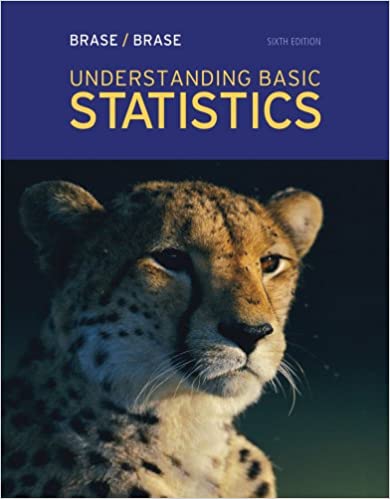
Understanding Basic Statistics 6th Edition by Charles Henry Brase,Corrinne Pellillo Brase
Edition 6ISBN: 978-1111827021
Understanding Basic Statistics 6th Edition by Charles Henry Brase,Corrinne Pellillo Brase
Edition 6ISBN: 978-1111827021 Exercise 61
Please provide the following information for Problems 11-22, part (a):
(i) What is the level of significance State the null and alternate hypotheses.
(ii) Check Requirements What sampling distribution will you use What assumptions are you making What is the value of the sample test statistic
(iii) Find (or estimate) the P -value. Sketch the sampling distribution and show the area corresponding to the P -value.
(iv) Based on your answers in parts (i) - (iii), will you reject or fail to reject the null hypothesis Are the data statistically significant at level a
(v) Interpret your conclusion in the context of the application.
Note: For degrees of freedom d.f. not in the Student's t table, use the closest d.f. that is smaller. In some situations, this choice of d.f. may increase the P -value a small amount, and therefore produce a slightly more "conservative" answer.
Answers may vary due to rounding.
Survey: Outdoor Activities A Michigan study concerning preference for outdoor activities used a questionnaire with a six-point Likert-type response in which 1 designated "not important" and 6 designated "extremely important." A random sample of n 1 = 46 adults were asked about fishing as an outdoor activity. The mean response was
 . Another random sample of n 2 = 51 adults were asked about camping as an outdoor activity. For this group, the mean response was
. Another random sample of n 2 = 51 adults were asked about camping as an outdoor activity. For this group, the mean response was
 . From previous studies, it is known that 1 = 1.5 and 2 = 1.2. Note: A Likert scale usually has to do with approval of or agreement with a statement in a questionnaire. For example, respondents are asked to indicate whether they "strongly agree," "agree," "disagree," or "strongly disagree" with the statement.
. From previous studies, it is known that 1 = 1.5 and 2 = 1.2. Note: A Likert scale usually has to do with approval of or agreement with a statement in a questionnaire. For example, respondents are asked to indicate whether they "strongly agree," "agree," "disagree," or "strongly disagree" with the statement.
(a) Do these data indicate a difference (either way) regarding preference for camping versus preference for fishing as an outdoor activity Use a 5% level of significance.
(b) Find a 95% confidence interval for 1 - 2. Explain the meaning of the confidence interval in the context of the problem.
(i) What is the level of significance State the null and alternate hypotheses.
(ii) Check Requirements What sampling distribution will you use What assumptions are you making What is the value of the sample test statistic
(iii) Find (or estimate) the P -value. Sketch the sampling distribution and show the area corresponding to the P -value.
(iv) Based on your answers in parts (i) - (iii), will you reject or fail to reject the null hypothesis Are the data statistically significant at level a
(v) Interpret your conclusion in the context of the application.
Note: For degrees of freedom d.f. not in the Student's t table, use the closest d.f. that is smaller. In some situations, this choice of d.f. may increase the P -value a small amount, and therefore produce a slightly more "conservative" answer.
Answers may vary due to rounding.
Survey: Outdoor Activities A Michigan study concerning preference for outdoor activities used a questionnaire with a six-point Likert-type response in which 1 designated "not important" and 6 designated "extremely important." A random sample of n 1 = 46 adults were asked about fishing as an outdoor activity. The mean response was
 . Another random sample of n 2 = 51 adults were asked about camping as an outdoor activity. For this group, the mean response was
. Another random sample of n 2 = 51 adults were asked about camping as an outdoor activity. For this group, the mean response was  . From previous studies, it is known that 1 = 1.5 and 2 = 1.2. Note: A Likert scale usually has to do with approval of or agreement with a statement in a questionnaire. For example, respondents are asked to indicate whether they "strongly agree," "agree," "disagree," or "strongly disagree" with the statement.
. From previous studies, it is known that 1 = 1.5 and 2 = 1.2. Note: A Likert scale usually has to do with approval of or agreement with a statement in a questionnaire. For example, respondents are asked to indicate whether they "strongly agree," "agree," "disagree," or "strongly disagree" with the statement.(a) Do these data indicate a difference (either way) regarding preference for camping versus preference for fishing as an outdoor activity Use a 5% level of significance.
(b) Find a 95% confidence interval for 1 - 2. Explain the meaning of the confidence interval in the context of the problem.
Explanation
(a)-(i)
The level of significance is
...
Understanding Basic Statistics 6th Edition by Charles Henry Brase,Corrinne Pellillo Brase
Why don’t you like this exercise?
Other Minimum 8 character and maximum 255 character
Character 255


